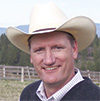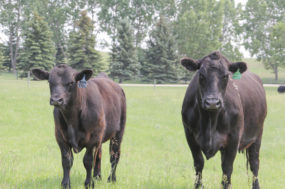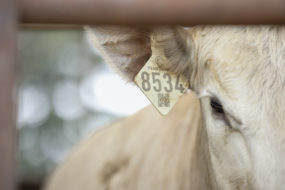The wind likes to blow on a regular basis in many areas of the country during the winter months. Couple this wind with cold temperatures and wet conditions, and the wind chill can cause a great deal of stress for cattle.
Cattle can stand cold temperatures as long as there is no wind. When wind and cold temperatures are combined, you have the perfect recipe for cold stress, which can have a detrimental effect on cattle health, performance and profitability. As a general rule of thumb, a 20-mph wind is equivalent to an additional 30ºF of cold.
Cattle experiencing cold stress will require more energy in their diets to generate body heat and maintain their proper core body temperature. In fact, for every 10ºF decline in temperature below 30ºF, due to wind chill, the energy requirement for a cow goes up 13 percent, which increases winter feed costs.
Cold stress can also contribute to an increase in sickness in the herd, thus increasing veterinary and treatment costs.
Therefore, cattle producers ranching in windy areas who do not currently have windbreaks should seriously consider providing them for their herds.
What type of windbreak will work?
The cheapest option would be to use natural windbreaks on the ranch if they are available. Dense brush in draws make excellent windbreaks. However, these areas may not be available when cattle are being fed during the winter feeding period.
There are several permanent and temporary windbreak designs that work well to block the wind. In snowy areas, the windbreak has to be designed to divert the snow and not pile it up on the cattle as they stand next to the windbreak.
The accompanying pictures show examples of three windbreak designs. The first is a semi-circular design, the second picture is an L-shaped design, and the third is a diagram of a V-shaped design.
These three designs do a nice job of directing snow away from the cattle. Of course, a straight-line fence will also work, as long as the windbreak fence is not solid-sided.
Building windbreak fences
The windbreak fence needs to be porous, meaning that some air should be able to flow through the windbreak fence. With a solid fence made of something like plywood, the wind will go up and over and then dip right back down again.
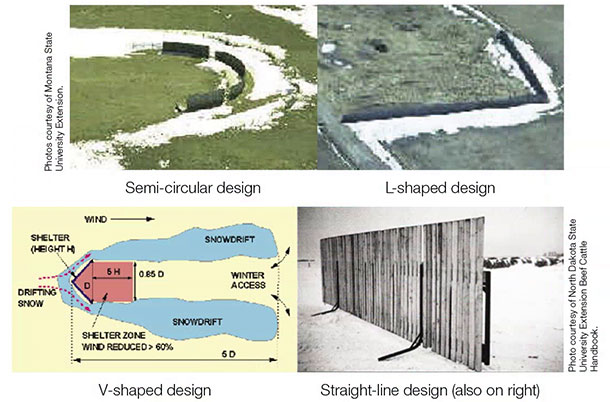
If snow is drifting, it will drift in front of the fence and directly behind the fence. If cattle were standing behind the fence, they would be covered with snow.
If the fence has slats, some of the air goes through the fence at a much more reduced speed, which gives wind and drift protection in an area eight to 10 times larger than the height of the fence. So for instance, if you had a 10-foot-high windbreak fence with slats, the area behind the fence protected from the wind would extend approximately 100 feet from the fence.
In the accompanying pictures is an example of a windbreak fence with spaces between the planks to allow a small amount of air through the fence.
How much porosity is needed?
Porosity is the amount of space between the planks that allows the air to flow through the windbreak fence. Experts recommend the windbreak fence should have a porosity of 25 to 33 percent.
To obtain a 25 percent level of porosity, 6-inch boards should be spaced 2 inches apart. For 33 percent porosity, 6-inch boards should be spaced 3 inches apart.
Fence height – how tall?
It is recommended the windbreak fence be at least 10 feet tall. If you remember, the downwind area that is protected from the wind will be eight to 10 times the height of the fence, therefore with a 10-foot fence, we will have a protected area of 100 feet behind the fence.
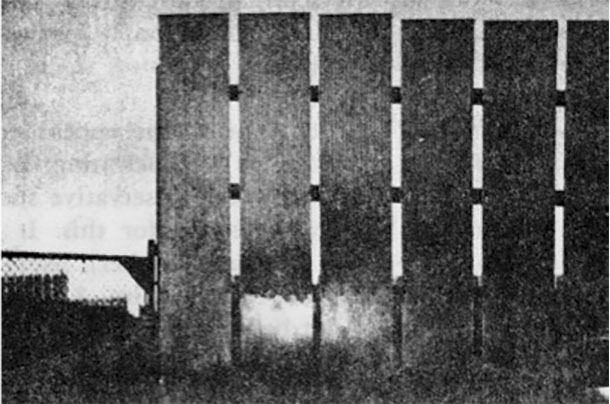
Also, as a general rule of thumb, allow 1 foot of fence, in length, for every cow.
Temporary windbreaks
In Canada, they are doing a lot of work with temporary or portable windbreaks. These portable models are built with a variety of materials, but the most common is made of a heavy-duty steel tubing frame with 2”x6” planks attached to them.
The key to portable windbreaks is: They must be built very stout to withstand the wind, the cattle rubbing on them and stay together when they are moved.
The typical portable windbreak is 10 feet tall. In order to stay upright against the wind, the base of the portable windbreak must be at least the same width or greater than the height of the fence. So a 10-foot-tall portable windbreak would need at least a 10-foot-wide base.
What have we learned?
- Wind coupled with cold temperatures and wet conditions can cause cold stress.
- A 20-mph wind is equivalent to an additional 30ºF of cold.
- For every 10ºF decline in temperature below 30ºF, the energy requirement for a cow goes up 13 percent.
- Windbreaks reduce cold stress in cattle.
- Several windbreak designs are available. Consider snow drift patterns when building a windbreak.
- Windbreak fences should not be solid.
- A porosity of 25 to 33 percent is recommended.
- A windbreak fence should be at least 10 feet tall. This will provide 100 feet of protection behind the fence.
- Allow 1 foot of fence length per cow.

PHOTO: Photos courtesy of Montana State University Extension, and North Dakota State University Extension Beef Cattle Handbook.
References omitted but are available upon request. Click here to email an editor.

-
Jim Church
- Extension Educator
- University of Idaho Extension
- Email Jim Church
